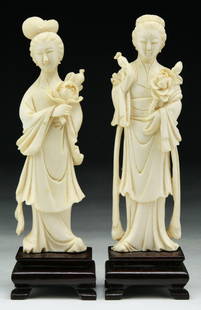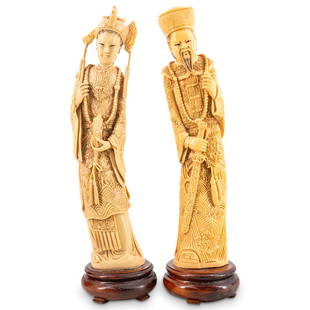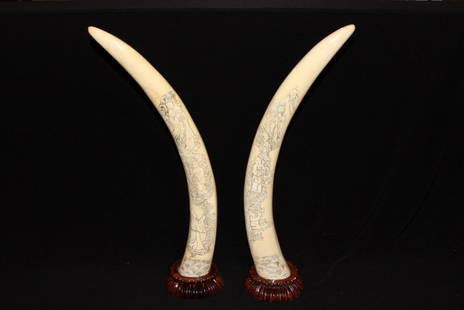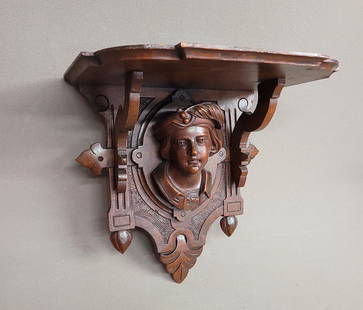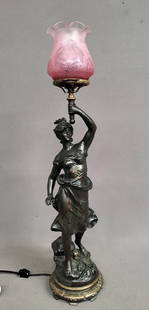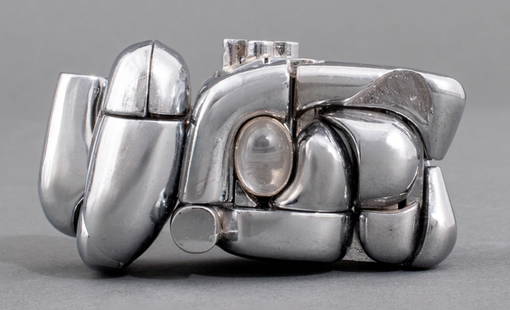
Chinese Carved Ivory Circa, 1930
Similar Sale History
View More Items in Sculptures & CarvingsRelated Sculptures & Carvings
More Items in Sculptures & Carvings
View MoreRecommended Art
View More







Item Details
Description
Description: This is a reticulated carved ivory statue signed on the base. He is standing at 12" high, holding a scroll in his right hand and a branch in his left. There is a child clinging on to his robes. Detailed so you can see the writing on the scrolls, fruit on the branch, and his beard and mustache. Created in 1930.
History: The tradition of depicting humans who have become immortals is an ancient practice in Chinese art, and when religious Taoism gained popularity, it quickly picked up this tradition with its own immortals. While cults dedicated to various Taoist immortals date back to the Han dynasty, the popular and well-known Eight Immortals first appeared in the Jin dynasty. The art of the Jin tombs of the 12th and 13th centuries depicts a group of eight Taoist immortals in wall murals and sculptures. They officially became known as the Eight Immortals in the writings and works of art of the Taoist group known as the Complete Realization (Quanshen). The most famous art depiction of the Eight Immortals from this period is a mural of them in the Eternal Joy Temple (Yongle Gong) at Ruicheng. The Eight Immortals are considered to be signs of prosperity and longevity, so they are popular themes in ancient and medieval art. They were frequent adornments on celadon vases. They were also common in sculptures owned by the nobility. Their most common appearance, however, was in paintings. Many silk paintings, wall murals, and wood block prints remain of the Eight Immortals. They were often depicted either together in one group, or alone to give more homage to that specific immortal. An interesting feature of early Eight Immortal artwork is that they are often accompanied by jade hand maidens, commonly depicted servants of the higher ranked deities, or other images showing great spiritual power. This shows that early on, the Eight Immortals quickly became eminent figures of the Taoist religion and had great importance[citation needed]. We can see this importance is only heightened in the Ming and Qing dynasties. During these dynasties, the Eight Immortals were very frequently associated with other prominent spiritual deities in artwork. There are numerous paintings with them and the Three Stars (the gods of longevity, prosperity, and good fortune) together. Also, other deities of importance, such as the Queen Mother of the West, are commonly seen in the company of the Eight Immortals. The artwork of the Eight Immortals is not limited to paintings or other visual arts. They are quite prominent in written works too. Authors and playwrights wrote numerous stories and plays on the Eight Immortals. One famous story that has been rewritten many times and turned into several plays (the most famous written by Mu Zhiyuan in the Yuan Dynasty) is The Yellow-Millet Dream, which is the story of how Lu Dòngbin met Zhongli Quan and began his path to immortality.
Provenance: N/A
Dimensions: Weight (Pounds & Ounces) = 0.5 | Height(in) = 12 | Width(in) = 3 | Depth(in) = 3
Size of Artwork(in): 12 x 3 x 2.5"
Artist Name: China
Medium: Ivory
Circa: Circa 1930
History: The tradition of depicting humans who have become immortals is an ancient practice in Chinese art, and when religious Taoism gained popularity, it quickly picked up this tradition with its own immortals. While cults dedicated to various Taoist immortals date back to the Han dynasty, the popular and well-known Eight Immortals first appeared in the Jin dynasty. The art of the Jin tombs of the 12th and 13th centuries depicts a group of eight Taoist immortals in wall murals and sculptures. They officially became known as the Eight Immortals in the writings and works of art of the Taoist group known as the Complete Realization (Quanshen). The most famous art depiction of the Eight Immortals from this period is a mural of them in the Eternal Joy Temple (Yongle Gong) at Ruicheng. The Eight Immortals are considered to be signs of prosperity and longevity, so they are popular themes in ancient and medieval art. They were frequent adornments on celadon vases. They were also common in sculptures owned by the nobility. Their most common appearance, however, was in paintings. Many silk paintings, wall murals, and wood block prints remain of the Eight Immortals. They were often depicted either together in one group, or alone to give more homage to that specific immortal. An interesting feature of early Eight Immortal artwork is that they are often accompanied by jade hand maidens, commonly depicted servants of the higher ranked deities, or other images showing great spiritual power. This shows that early on, the Eight Immortals quickly became eminent figures of the Taoist religion and had great importance[citation needed]. We can see this importance is only heightened in the Ming and Qing dynasties. During these dynasties, the Eight Immortals were very frequently associated with other prominent spiritual deities in artwork. There are numerous paintings with them and the Three Stars (the gods of longevity, prosperity, and good fortune) together. Also, other deities of importance, such as the Queen Mother of the West, are commonly seen in the company of the Eight Immortals. The artwork of the Eight Immortals is not limited to paintings or other visual arts. They are quite prominent in written works too. Authors and playwrights wrote numerous stories and plays on the Eight Immortals. One famous story that has been rewritten many times and turned into several plays (the most famous written by Mu Zhiyuan in the Yuan Dynasty) is The Yellow-Millet Dream, which is the story of how Lu Dòngbin met Zhongli Quan and began his path to immortality.
Provenance: N/A
Dimensions: Weight (Pounds & Ounces) = 0.5 | Height(in) = 12 | Width(in) = 3 | Depth(in) = 3
Size of Artwork(in): 12 x 3 x 2.5"
Artist Name: China
Medium: Ivory
Circa: Circa 1930
Condition
He has several age checks on neck, left side. Good condition.
Buyer's Premium
- 24.5%
Chinese Carved Ivory Circa, 1930
Estimate $800 - $1,200
7 bidders are watching this item.
Shipping & Pickup Options
Item located in West Palm Beach, FL, usSee Policy for Shipping
Payment

TOP



















